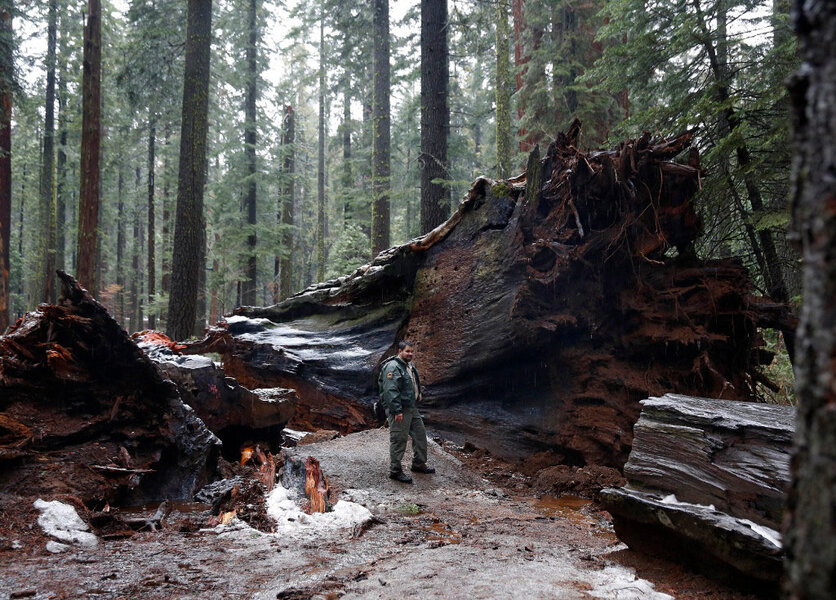Storm topples California drive-thru tree. Can we save the remaining sequoias?
Loading...
No one knows when exactly the northern California sequoia named Pioneer Cabin first put down roots. But when a storm toppled the ancient tree Sunday night, nature fans around the world mourned its death. After the Calaveras Big Tree Association announced, “The Pioneer Cabin Tree has fallen!”, Facebook users posted more than 2,700 messages with condolences on the group’s page.
Pioneer Cabin belonged to the species Sequoiadendron giganteum, better known as “giant sequoias.” Though not as tall as their relatives, the Coast Redwoods, giant sequoias are more massive. In 1880, tourism promoters cut a tunnel through Pioneer Cabin’s base.
Three other drive-through trees remain in California, but don’t expect any more. Most of the state’s redwoods and sequoias are now under state or federal protection. "Tunnel trees had their time and place in the early history of our national parks," the National Parks Service writes on its website. "But today sequoias which are standing healthy and whole are worth far more."
Pioneer Cabin faced the excesses of a "time and place" that had little regard for conservation. But it also saw the rise of an environmental consciousness – and policies – that have spared sequoia groves further damage. Pioneer Cabin may have fallen, but its neighbors continue to enjoy state protection – although the trees also face new manmade threats.
When explorers first reached Pioneer Cabin’s grove, about 100 miles southeast of Sacramento, in the mid-19th century, they knew they had found something special. Other Americans soon agreed: As railroads and stage coaches made California more accessible after the Civil War, California’s old-growth forests saw a surge in tourism.
Between 1853 and 1864, a total of 653 recorded visitors reached Yosemite Valley. By 1874, the Valley hosted more than 2,700 visitors each year. Many of them likely took time to see the nearby Mariposa Grove, also home to giant sequoias.
These early visitors’ habits would make modern conservationists cringe. At first, access to California’s wonders was controlled by private tour operators, who developed a wide range of gimmicks to attract visitors. Pioneer Cabin’s tunnel was one of these ploys. Meanwhile, in Mariposa Grove, “any person could name a tree. Parties desiring a permanent designation were required to donate a sign with the name painted on it. Some people sent white marble name plates and others metal ones,” historian Linda W. Greene wrote in a 1987 study on Yosemite.
Slowly, attitudes changed. After aggressive lobbying by John Muir and other conservationists, in 1890 Congress declared Yosemite a National Park. Other unique ecosystems followed suit, prompting the creation of the National Parks Service in 1916. State park systems extended the trend further; California added Calaveras Big Trees State Park, where Pioneer Cabin stood, to its system in 1931. Today, 13 percent of US land area falls under some kind of protected status.
This bodes well for Pioneer Cabin’s neighbors. But sequoias also face new threats in the 21st century. Although the trees may be well suited to withstand climate change, it's too early too tell how they will fare in an age of more frequent forest fires. The national and state parks systems themselves may come in for changes, given the GOP 2016 platform's push to transfer more federally controlled public lands to the states. Recent budget cuts have left some states struggling, prompting many state parks to slash programs or visiting hours, and seek out new funding sources, from zip-lining to corporate sponsorships.
However this trend plays out in California, the state’s sequoias will likely see it firsthand. In 2015, the state’s Parks Department acknowledged that it had been in “crisis mode,” and that “service levels are declining due primarily to rising costs, declining revenues and mission creep.” Now, those who mourned Pioneer Cabin’s passing will have their eyes on California’s Parks Forward Commission, tasked with addressing these problems, to preserve remaining sequoias for future generations.







